Perhaps the salient thing about food, from a photographer’s point of view, is that it doesn’t last. Even the most gorgeous, curvaceous pepper – those shot by Edward Weston in 1930 are among the camera’s greatest still lifes – must either be chopped up and eaten, or rot.
Back in 1977, Deborah Barsel, a bored employee at George Eastman House in New York, home to the US’s finest photography collection, had the idea of asking artists to contribute food-related pictures and recipes to a cookery book. Nearly 40 years on, the project has been brought to fruition after a box of letters and pictures from the likes of surrealist legend Brassaï and William Eggleston, who captured the US south, was discovered in a store room.
It’s a great idea whose time has come. Quality cookbooks in 1977 were more likely to be illustrated with sensitive line drawings such as John Minton’s for Elizabeth David’s classics on southern European food. Today, photography and cookery are inseparable. I recently went to a restaurant whose lavishly photographed recipe book I own. It was a chance to order dishes whose pictures I have been looking at for years, including ones that are too fussy to cook at home. Damn, no cod cheeks in the fridge! So I ordered the cod cheeks and, yes, they were as good as their photograph.
Now, when I look at the picture, I’ll remember the taste, the time, the fun. Food’s impermanence makes it the stuff of richly associative memories such as these. I wish I had been at the New York restaurant where Stephen Shore photographed the aftermath of a meal in 1972. It must have been a good one. Black coffee, and a cigar. The sharp colours tell of a meeting, a conversation, maybe business, maybe love: all the social stuff of city lunches. Or was he eating alone?
Real character in photography comes from a precise, rich engagement with the suggestiveness of the physical world. That cigar in Shore’s ashtray, the cherry garnish on a Neal Slavin hotdog. Eggleston’s cheese grits casserole, using half a pound of Velveeta cheese, sits alongside his 1976 photograph of an empty diner, whose bright yellow walls evoke the cheese he likes to melt all over his down home food.
As with most of the contributors, Eggleston shares a fondness for ingredients that are now practically illegal on health grounds: this is the 1970s, and the dishes are steeped in the saturates of the time – graham crackers, frozen macaroni cheese. This is a cookbook to look at rather than use, if you value your arteries.
Food is not a fetishistic obsession for great photographers, it seems, so much as a movable feast, a theatrical moment in the midst of everyday life. Eileen Cowin’s vegetable cheese casserole is just lots of veg baked in ricotta: fast and easy, to suit the chaotic lifestyle portrayed in her shot of a kid watching TV from the same table as a couple trying to have a candlelit dinner (pictured overleaf).
Photography is the art of modern life’s flux; the moments that make the best pictures may not be food on a plate so much as pots in a sink, people at a counter, coffee on a stove. Above all, food is social: in Barbara Crane’s rawly coloured snapshot of people passing slices of pizza at a party, the sharing is what it’s all about.
When this lovely project was launched, photography was at a crossroads: modernist masters such as Ansel Adams were still composing pictures of great formal beauty while younger photographers were recording more random scenes. Artists such as Ed Ruscha were exploring the camera’s power as a conceptual tool. These pictures allow us to savour a great moment, melting in the mouth like Velveeta cheese.
Pavlova: Grant Mudford
There are many things from Australia I remember with great affection, partly due to their absence elsewhere in the world. I truly miss: old Holdens (cars), gladioli (flowers), galas and kookaburras (birds), Ayers Rock (natural monument) and the bush (outback country). Australian cuisine on the whole is forgettable, with one notable exception: the pav! It’s named after the Russian dancer Anna Pavlova, who in 1926 performed Swan Lake in Australia. Description: a soft, marshmallow-centered dessert with crisp, lightly browned meringue crust, topped with whipped cream and fresh fruit.
Egg whites – use at least 8
2 rounded tbsp sugar per egg white
1 drop of vinegar per egg white
Heat the oven to 150C/300F/gas mark 2. Beat the egg whites until stiff. Add the sugar gradually while beating; add vinegar. Cover an oven tray with greased paper. Spread the mix out in a disc (nine or 10 inches in diameter), put in the oven, and turn down the heat to 110C/225F/gas mark ¼. Bake for one and a half hours.
Add toppings just before serving: whipped cream, strawberries, pineapple, cherries, kiwi and other fresh fruit.
Based in LA, Mudford is best known for his work with the architect Louis Kahn.
Cheese grits casserole: William Eggleston

Serves six to eight.
1 cup (160g) grits
1 tsp salt
4 cups (1 litre) water
1 stick (110g) butter
⅓ cup (80ml) milk
½ pound (230g) Velveeta cheese
3 eggs, slightly beaten
Cook the grits in salted water until done. Add butter, cheese, eggs and milk. Stir until melted and smooth. Place in a quart casserole, and bake for an hour at 180C/350F/gas mark 4.
Now 76, Eggleston has won multiple awards for his vivid portraits of the US.
Key lime pie supreme: Stephen Shore
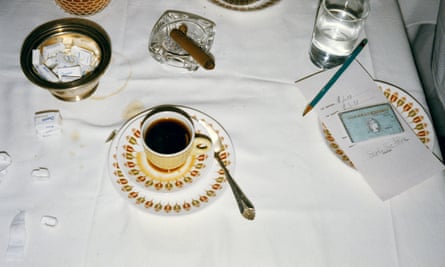
For the crust
Make a graham cracker (digestive) crust, using brown sugar.
For the filling
1 cup (200g) sugar
¼ cup (30g) flour
3 tbsp cornstarch
¼ tsp salt
2 cups (500ml) water
3 egg yolks
1 tbsp butter
Juice of 2 limes, about ½ cup (125ml)
Grated rind of 2 limes
Topping
Heavy whipping cream
Combine the sugar, flour, cornstarch and salt in a saucepan, and stir in the water gradually. Cook on medium heat until thickened, add the beaten egg yolks gradually, return to a low heat and cook for two minutes, stirring constantly. Stir in the butter, lime juice, and rind, and allow to cool slightly. Pour into the baked pastry shell and cool. Top with whipped cream sweetened with sugar. Born in 1947, Shore’s work has centred on US road trips and everyday life.
Nylen’s frankfurters in full dress: Neal Slavin
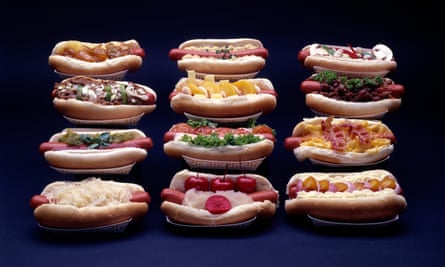
My most delightful and favourite “tidbit gastronomique” is called the “Nylen full-dress frank.” It’s named after a colleague, Judy Nylen, who not by chance is also its creator. The frankfurter need not be left naked. It can be formalised and decked out for a sumptuous midnight snack or fun party fare. Condiments, garnishes and accents can take on any theme. Those described below are “regional costumes” to be grouped buffet-style for a party, so guests can create their own masterpieces.
Basics (for a party of 24)
48 frankfurters
48 buns
Bring six quarts of water to a boil in one or more large pots. Remove from the heat and put in the frankfurters. Cover and let stand for seven minutes. Serve right from the pot, or keep warm on a hot tray set to low; they’ll also keep for several hours in warm water.
Dressings: New Yorker
2 cups (300g) sauerkraut
Heat the sauerkraut through and keep warm on a hot tray; smother the frankfurter.
German
1 cup (250ml) apple sauce
1 cup (120g) crab apples, sliced
Spoon the sauce over the frankfurter, and garnish with crab apple slices.
Southern
2 cups (400g) frozen macaroni and cheese, baked according to package
½ pound (450g) bacon, cut in half and fried until lightly crisp
1 cup (100g) cheddar cheese
Spoon macaroni on to the bun, put in a frankfurter, cover with a little more macaroni, top with bacon and grated cheese, and melt in toaster oven.
Californian
1 pint cherry tomatoes, sliced
1 head curly Spanish lettuce
½ cup (125ml) thousand island dressing
Put lettuce under a frankfurter sliced lengthwise; stuff with tomato down the centre and top with dressing.
Mexican
4 peppers, cut into rings
2 cups (500ml) chilli con carne, without beans
1 cup (150g) onion, finely chopped
Heat the chilli and keep warm on hot tray. String peppers – three or four rings – on to a frankfurter, and top with chilli and onions.
Chinese
½ cup (60g) water chestnuts, sliced
1 cup (120g) canned sliced peaches
½ cup (60g) bamboo shoots, sliced
½ cup (125ml) sweet and sour sauce
Cut short, diagonal slits in a frankfurter and stuff with water chestnuts. Top with peaches, bamboo shoots and sauce.
Middle Eastern
1 cup (120g) kumquats, peeled and quartered
1 large red onion, sliced in rings
½ cup (125ml) mayonnaise
Slice a frankfurter lengthwise and stuff with three or four kumquat quarters, alternating with red onion. Surround with mayonnaise.
Irish
2 cups (500g) pickle relish
1 small bunch watercress
Smother a frankfurter in relish, and garnish with watercress “clovers”.
New Englander
2 cups (600g) baked beans
1 bunch curly parsley
Heat the beans and keep warm on hot tray; spoon over a frankfurter and garnish with parsley.
Polynesian
1 cup (120g) pineapple rings, halved
½ cantaloupe melon, cubed
½ cup (125g) mango chutney
Place pineapple rings over the frankfurter, garnish with cantaloupe and top with chutney.
All-American
1 cup (250ml) brown mustard (or any favourite mustard)
¼ cup (12g) snipped chives
Smother in the traditional manner.
Italian
1 cup (250ml) pizza sauce
1 cup (80g) grated mozzarella
1 red pepper, cut into thin strips
1 green pepper, cut into thin strips
12 fresh mushrooms, sliced
Keep the sauce warm on a hot tray. Spoon over bun, put in frankfurter and top with cheese, pepper strips and mushrooms. Put frankfurter in toaster oven to melt cheese.
Neal Slavin specialises in group portraits. He is also a TV/film director.
Eggs poached in beer: Ansel Adams
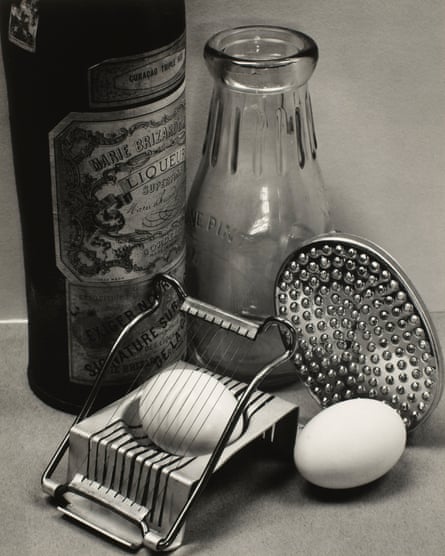
¼ cup (60g) butter
Mixed spices
1 dash sherry
1 bottle dark malt liquor or strong ale
¼ tsp salt
2 eggs
2 pieces toast
A pinch of paprika
Melt the butter in a microwave, but do not allow to brown. Add a dash of mixed spices and sherry. In a bowl, microwave the malt with the salt to boiling point. Slide the eggs into the hot liquid, cover with a paper plate or glass bowl and cook in the microwave as desired (see below).
While the eggs are cooking, make two pieces of toast. Spread part of the butter-spice mix over the toast.
Serve the eggs on the toast, and pour over the rest of the butter-spice mix. Add a dash of paprika.
Note on microwave cooking I like my eggs poached soft. I find that one egg in the hot ale or malt takes about one minute to cook, two eggs about two minutes, etc, all the way up to eight eggs about eight minutes.
Ansel Adams is best known for his photographs of the American West.
Zwei vier minuten eier Ralph Steiner
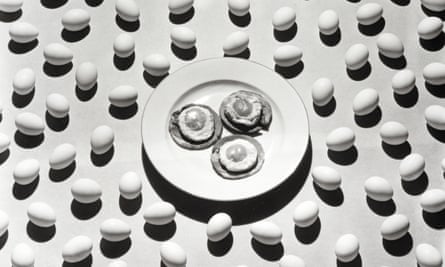
I am more a basse cuisine than haute cuisine chef. I got my Cordon Bleu not in Paris but in Erie, Pennsylvania. There I learned: a) how to take a box of cornflakes down from the shelf; b) how to boil two four-minute eggs. Eggs are important! You recall Samuel Butler’s solution of the ancient question, “Which came first, the chicken or the egg?” He said: “The egg came first: a chicken is only an egg’s way of making another egg.” Now for my favourite/only recipe.
One puts water an egg’s diameter deep into a pan. Turns heat on. When boiling briskly, drops two eggs in from low altitude. Turns heat off. One watches one’s watch watchfully for 240 seconds. At the stroke of 240, one removes eggs. On opening eggs, I always get bits of shell – or is it “will”? – in my eggs. I never know when to use “shell” and when to use “will”. Never mind; a bit of shell ingested gives a man shell power.
Ralph Steiner was a US photographer and pioneering documentary-maker.
Cheesecake: Barbara Crane
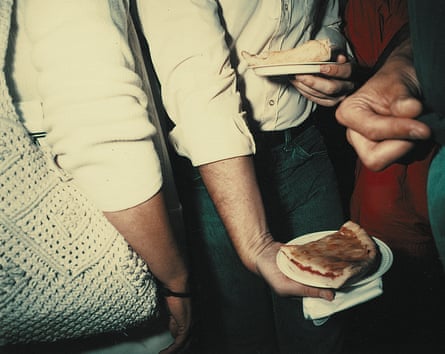
I love to eat, as long as someone else cooks it. I especially love cheesecake.
1 graham cracker (digestive) crust
12 ounces (340g) cream cheese
1 cup (240g) cottage cheese
¾ cup (175g) sugar
1 tsp vanilla
⅛ tsp ground nutmeg
2 eggs
¼ tsp ground cinnamon
1 21oz can (595g) cherry pie filling
Combine three packs of cream cheese with a cup of cottage cheese, and mix with electric mixer until smooth; beat in the sugar, vanilla, and nutmeg. Add the eggs one at a time, beating well after each; measure out a cup of the mixture and set aside. Pour the remaining cheese mixture into the crust.
Bake for 30 minutes at 180C/350F/gas mark 4. Meanwhile, take the rest of the cheese mixture and the fourth pack of cream cheese, mix in a bowl and beat until smooth. Take a pastry bag with a round tip and fill with the mixture: you will use this to decorate the cake. Add the cinnamon to the cherry pie filling.
Remove the cheesecake from the oven at the end of 30 minutes. Raise the oven temperature to 230C/450F/gas mark 8. Spread the cherry filling over the cheesecake. Take the pastry bag and decorate the top. Bake the decorated cheesecake in the hot oven for 10 minutes, or until the top is browned. Cool on a wire rack and serve at room temperature.
Crane’s work, much of it experimental, is in galleries around the world.
Vegetable cheese casserole: Eileen Cowin

There is a scene in Even Cowgirls Get The Blues, by Tom Robbins, where someone sprays a special substance on different foods to make them taste like chocolate chip cookies. That would be my favorite recipe, if I could find it. Since I haven’t…
Saute in very little oil: onions, mushrooms, broccoli, tomatoes (you can substitute any combination of vegetables in any amounts.) Add spices/herbs: garlic, salt, pepper, basil. (Again, changing or adding different combinations makes the dish taste different every time you make it.) Saute the vegetables until they are a little tender, remove from the stove, and put in a casserole.
Mix ricotta – one cup (250g) of ricotta to every three cups (750g) vegetables, or to taste – with salt, pepper, parsley, and egg (one egg per 250g of cheese). Add the ricotta mixture to the vegetables and bake at 180C/350F/gas mark 4 for 25 minutes. For the last five minutes, put thinly sliced mozzarella over the top of the casserole.
I hope this isn’t too loose, but the best part of this is making up your own variations. If you want, you can find that special substance and make the whole thing taste like a chocolate chip cookie.
Born in 1947, Cowin’s work draws on the traditions of narrative painting.

Comments (…)
Sign in or create your Guardian account to join the discussion